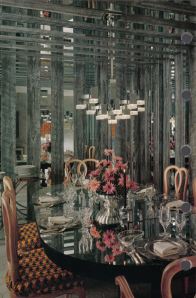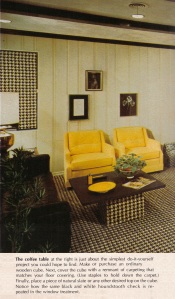Monochromatic (or Nearly-Monochromatic) Rooms
A monochromatic room is, loosely speaking, a room where all the furnishings and wall treatments use only tints and shades of one single color (plus black and white). This is a design technique common to every decade. Below is a collection of 1970s monochromatic – or nearly monochromatic – interiors for your delight. These images may overlap other posts.
Heavily Patterned Rooms
Heavily patterned rooms are one of my favorite characteristics of 1970s interiors. Repeating the same pattern on multiple surfaces can help unify a room and bring in a pre-assembled color scheme. The photographs from my interior design books often mix and match carpet, tile, fabric, and wallpaper in identical patterns. Unfortunately, it is very unlikely that you will find a seventies-esque pattern that you adore in more than one material today. I have no idea how one might replicate the above room in a modern home – with matching tile, vinyl seats, fabric curtains, and wallpaper – or even the room below with just the matching carpet and curtains:
The most realistic way to achieve this aesthetic in your home would be to repeat a pattern using a single material — and the material that has the widest use in a home is fabric. Cushions, bedspreads, pillows, curtains, tablecloths, lampshades, walls, and ceilings are all surfaces that can be simply covered/made with matching fabrics. (I have never attached fabric to a wall, but I would not imagine it would be harder than pasting wallpaper.) The key is to pick a few items to “reupholster” per room – not too many…or god forbid, all:
Fabric has few limitations. (Or perhaps it is more appropriate to say that every creative person has a few limitations.) Reupholstering cushions, for example, is not a large task, but reupholstering entire couches requires an expertise that I am not prepared for:
Realistic Projects with Fabric
Other than the shortcomings of your own skill, you can experiment with practically endless utilizations of fabric. Here are some examples using cushions, bedspreads, curtains, lampshades, and walls:
If you have have found a non-fabric material in a breathtaking pattern, you could of course try to make good use of it in multiple locations as well. Sadly the below photo is achieved with a vinyl tile which would be impossible to buy today:
Citations and Notes
The opening image in this post comes from Family Circle Home Decorating Guide (1973), and the next four images come from Better Homes and Gardens Decorating Book (1975). In order of appearance, the images under “Realistic Projects with Fabric” come from: Decorating Ideas Under $100 (1971), The Practical Encyclopedia of Good Decorating and Home Improvement (1970), Family Circle Home Decorating Guide (1973), Better Homes and Gardens Decorating Book (1975), Family Circle Home Decorating Guide (1973), Family Circle Home Decorating Guide (1973), The Practical Encyclopedia of Good Decorating and Home Improvement (1970), and Better Homes and Gardens Decorating Book (1975). You will find many interiors with repeating patterns in this blog that are not included here. Subsequent posts will include information on how to upholster cushions and how to alter curtains.























